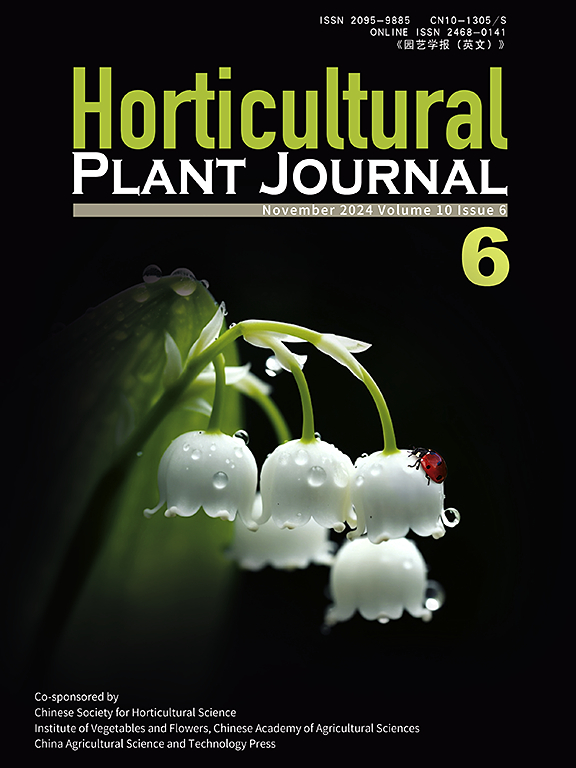通过畸形苗和次生胚的直接转化,提高无核葡萄胚拯救育种的效率
IF 6.2
1区 农林科学
Q1 HORTICULTURE
引用次数: 0
摘要
无籽是葡萄最有价值的农艺性状之一。胚胎抢救技术以其提高无籽后代比例、缩短育种周期等优点,在无籽葡萄育种中得到了广泛应用。为了提高无籽葡萄胚抢救育种的效率,本研究主要对无籽葡萄胚抢救过程中产生的异常苗进行抢救和再利用。通过分析19个杂交组合的亲本基因型对异常苗形成的影响,采用直接转化和体细胞胚发生两种方法对异常苗进行救援,研究了不同异常苗型和亲本基因型对救援效率的影响。另外,以3个杂交组合中异常苗的下胚轴分化出的次生胚为实验材料,建立体胚再生体系。结果表明,19个杂交组合中异常苗的平均比例(46.25%)显著高于正常苗的平均比例(33.06%)。异常苗型以无根叶白化和子叶白化最为常见。采用直接转化法,多子叶型异常苗抢救率最高,为53.06%,杂交组合“佩列特×火州翠玉”异常苗抢救率最高,为81.11%。此外,由异常幼苗的下胚轴衍生的次生胚能够发育为正常幼苗,从而使一些异常幼苗得以抢救。以“梅莉莎无核×本文章由计算机程序翻译,如有差异,请以英文原文为准。
Enhancing the efficiency of embryo rescue breeding in seedless grape via direct transformation of abnormal seedlings and secondary embryos
Seedlessness is one of the most valuable agronomic traits in grape. Embryo rescue technology, with its advantages of increasing the proportion of seedless progeny and shortening the breeding cycle, has been widely applied in seedless grape breeding. To improve the efficiency of embryo rescue breeding in seedless grape, this study focused on rescuing and reusing abnormal seedlings generated during the process. By analyzing the influence of parental genotypes from 19 cross combinations on the formation of abnormal seedlings and employing both direct transformation and somatic embryogenesis for their rescue, the study investigated the effects of different abnormal seedling types and parental genotypes on rescue efficiency. Additionally, using the secondary embryos differentiated from the hypocotyls of abnormal seedlings in 3 cross combinations as experimental materials, the aim is to establish a somatic embryo regeneration system. The results revealed that the average proportion of abnormal seedlings (46.25 %) across the 19 cross combinations was significantly higher than that of normal seedlings (33.06 %). Among the abnormal seedling types, leaves without roots and cotyledon albinism were the most prevalent. Using the direct transformation method, the polycotyledonous type exhibited the highest rescue efficiency at 53.06 %, while the cross combination “Perlette × Huozhoucuiyu” achieved the highest abnormal seedling rescue rate of 81.11 %. Furthermore, secondary embryos derived from the hypocotyl of abnormal seedlings were capable of developing into normal seedlings, enabling the rescue of some abnormal seedlings. A cyclic somatic embryogenesis system was established for grape hypocotyls in the crosses “Melissa Seedless × Lüzhoubaoshi” and “Zitian Seedless × Melissa Seedless”. This approach not only significantly enhanced the efficiency of embryo rescue but also expanded the potential applications of abnormal seedlings in somatic regeneration research, providing valuable receptor materials for grape genetic transformation systems.
求助全文
通过发布文献求助,成功后即可免费获取论文全文。
去求助
来源期刊

Horticultural Plant Journal
Environmental Science-Ecology
CiteScore
9.60
自引率
14.00%
发文量
293
审稿时长
33 weeks
期刊介绍:
Horticultural Plant Journal (HPJ) is an OPEN ACCESS international journal. HPJ publishes research related to all horticultural plants, including fruits, vegetables, ornamental plants, tea plants, and medicinal plants, etc. The journal covers all aspects of horticultural crop sciences, including germplasm resources, genetics and breeding, tillage and cultivation, physiology and biochemistry, ecology, genomics, biotechnology, plant protection, postharvest processing, etc. Article types include Original research papers, Reviews, and Short communications.
 求助内容:
求助内容: 应助结果提醒方式:
应助结果提醒方式:


